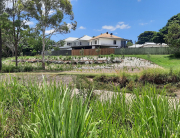Topic: Why we should change what the guidelines, codes and specifications say about Manning’s n in the design of grass-lined and rock-lined channels
Presenters: Martin Jacobs – Principal Hydraulics Engineer at Pitt&Sherry
Date: Thursday 23rd July 2020
Time: 1.00pm – 1:45pm
Description: Most guidelines, codes and specifications include tables of fixed Manning’s n values for different types of channels. A few include references to vegetal retardance types, but these are rarely used in practice. It is rarely recognised that Manning’s n varies with depth and that the values used for shallow flow should be much higher than deep flow. This often results in the adoption of inappropriate, low values in the design of shallow grass-lined and rock-lined channels such that the resulting channels could be one third, one quarter or one fifth the size required to convey the design flow. The dynamics of design-and-construct procurement of infrastructure pressure designers into adopting the most favourable, lowest possible value of Manning’s n, which are justified by placing onerous maintenance burdens (mowing) on asset owners.
There are established techniques to estimate the values of Manning’s n for grass-lined and rock-lined channels, based on the underlying theory and empirical experiments. Although they are tedious to work out manually, they can be completed computationally and Martin has developed a program.
By re-writing the codes, guidelines and specifications to recognise the depth-varying nature of Manning’s n, not only will there be better outcomes for design, but also asset owners can balance the competing demands of capital costs and maintenance and continuity can be achieved with water sensitive urban design, which favours the use of grass-lined channels with low velocities.
Registration: This webinar is FREE of charge to all. Follow the link below to register:












Leave A Comment
You must be logged in to post a comment.